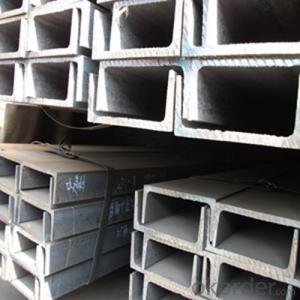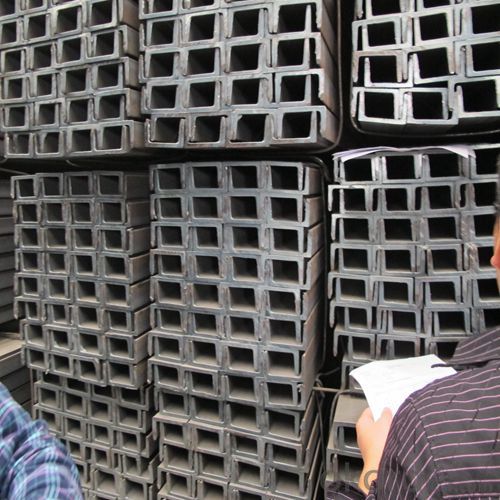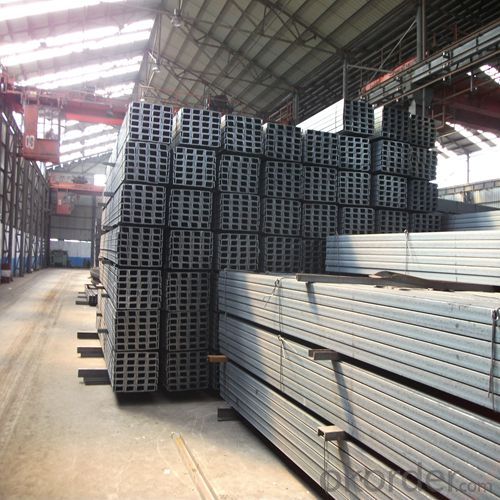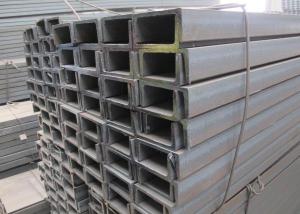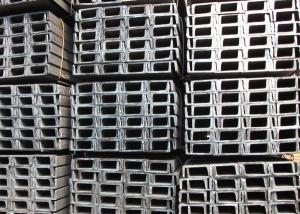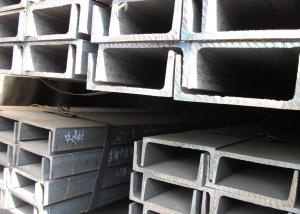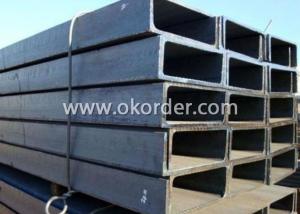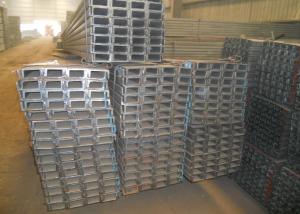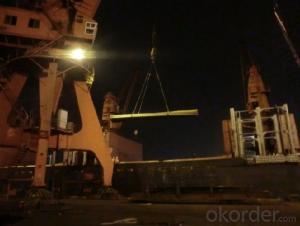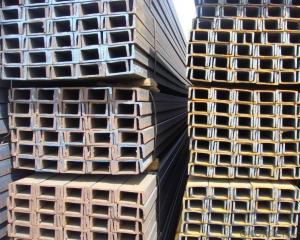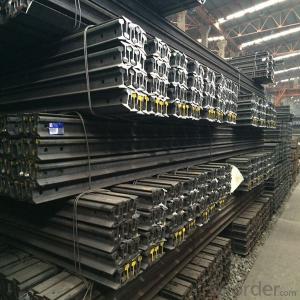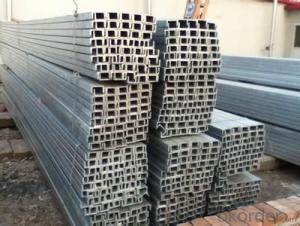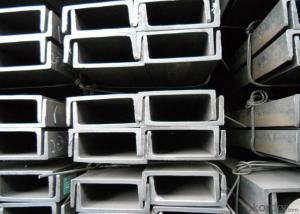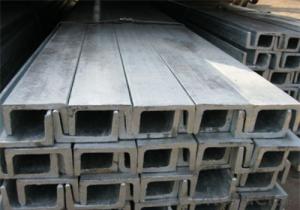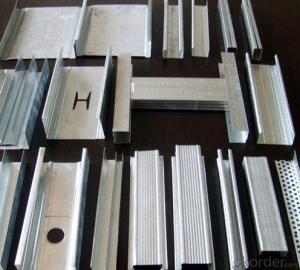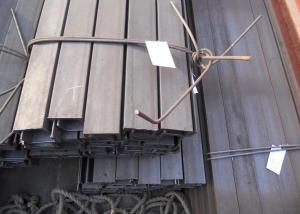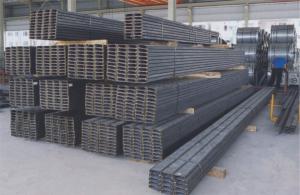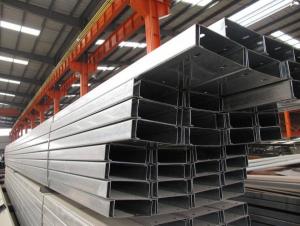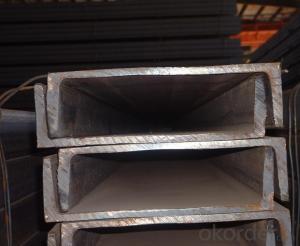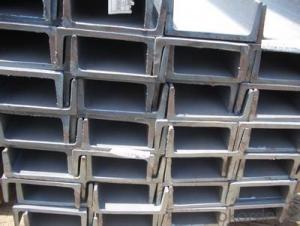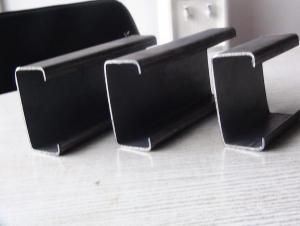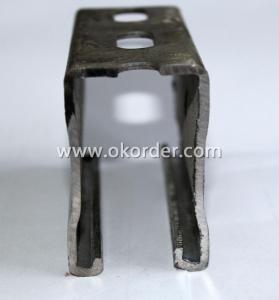U Channel Steel/Steel Channel /Galvanized Steel Channel Dimensions
- Loading Port:
- Tianjin
- Payment Terms:
- TT or LC
- Min Order Qty:
- 25 m.t.
- Supply Capability:
- 20000 m.t./month
OKorder Service Pledge
OKorder Financial Service
You Might Also Like
Product Description:
OKorder is offeringU Channel Steel/Steel Channel /Galvanized Steel Channel Dimensions at great prices with worldwide shipping. Our supplier is a world-class manufacturer of steel, with our products utilized the world over. OKorder annually supplies products to European, North American and Asian markets. We provide quotations within 24 hours of receiving an inquiry and guarantee competitive prices.
Product Applications:
U Channel Steel/Steel Channel /Galvanized Steel Channel Dimensions are ideal for structural applications and are widely used in the construction of buildings and bridges, and the manufacturing, petrochemical, and transportation industries.
Product Advantages:
OKorder's U Channel Steel/Steel Channel /Galvanized Steel Channel Dimensions are durable, strong, and resist corrosion.
Main Product Features:
· Premium quality
· Prompt delivery & seaworthy packing (30 days after receiving deposit)
· Corrosion resistance
· Can be recycled and reused
· Mill test certification
· Professional Service
· Competitive pricing
Product Specifications:
Specifications of MS Channel:
1.We supply high quality MS Channel at reasonable price, including Chinese standard, Japanese standard and so on.
Standard | GB/JIS |
Material Grade | Q235,SS400 |
Technique: | Hot Rolled |
Sizes as per chinese standard: | 50*37*4.5mm - 300*89*11.5mm |
Sizes as per japanese standard: | 50*25*3mm – 200*80*7.5mm |
Length: | 6meter, 9meter, 12meter |
Note: 1.we are also competent to provide our customers other MS Channel based on other sizes according to customer’s requirements.
2. The length of our ms channel could be cut into other meters as per customer’s requirements. For example, the channel in 6meters could be cut into 5.8meters in order to be fit in the 20ft container.
2. The detailed sections of MS Channel as per GB standard.are shown in the table-1:
GB U CHANNEL | Standard | Sectional | Dimension |
| Mass: |
| (mm) | (mm) | (mm) | (mm) |
|
50X37 | 50 | 37 | 4.50 | 7.0 | 5.438 |
63X40 | 63 | 40 | 4.80 | 7.5 | 6.634 |
80x43 | 80 | 43 | 5.00 | 8.0 | 8.045 |
|
|
|
|
|
|
100x48 | 100 | 48 | 5.30 | 8.5 | 10.007 |
120x53 | 120 | 53 | 5.50 | 9.0 | 12.059 |
140x58 | 140 | 58 | 6.00 | 9.5 | 14.535 |
140x60 | 140 | 60 | 8.00 | 9.5 | 16.733 |
|
|
|
|
|
|
160x63 | 160 | 63 | 6.50 | 10.0 | 17.240 |
160x65 | 160 | 65 | 8.50 | 10.0 | 19.752 |
|
|
|
|
|
|
180x68 | 180 | 68 | 7.00 | 10.5 | 20.174 |
180x70 | 180 | 70 | 9.00 | 10.5 | 23.000 |
|
|
|
|
|
|
200x73 | 200 | 73 | 7.00 | 11.0 | 22.637 |
200x75 | 200 | 75 | 9.00 | 11.0 | 25.777 |
|
|
|
|
|
|
220x77 | 220 | 77 | 7.00 | 11.5 | 24.999 |
220x79 | 220 | 79 | 9.00 | 11.5 | 28.453 |
|
|
|
|
|
|
250x78 | 250 | 78 | 7.00 | 12.0 | 27.410 |
250x80 | 250 | 80 | 9.00 | 12.0 | 31.335 |
250x82 | 250 | 82 | 11.00 | 12.0 | 35.260 |
|
|
|
|
| |
280x82 | 280 | 82 | 7.50 | 12.5 | 31.427 |
280x84 | 280 | 84 | 9.50 | 12.5 | 35.823 |
280x86 | 280 | 86 | 11.50 | 12.5 | 40.219 |
|
|
|
|
|
|
300x85 | 300 | 85 | 7.50 | 13.5 | 34.463 |
300x87 | 300 | 87 | 9.50 | 13.5 | 39.173 |
300x89 | 300 | 89 | 11.50 | 13.5 | 43.883 |
Table-1
3. The chemical composition of HR Channel Steel according to Q235B is shown in Table-2.
Alloy No | Grade | Element(%) | ||||
C | Mn | S | P | Si | ||
Q235 | B | 0.12-0.20 | 0.3-0.7 | ≦0.045 | ≦0.045 | ≦0.3 |
Table-2
Note: we are able to present our customers relevant SGS test report for chemical composition of HR Channel Steel.
4. The mechanical property of HR Channel Steel according to Q235B is shown in Table-3-1 and Table-3-2
Alloy No | Grade | Yielding Strength Point(Mpa) | |||
Thickness(mm) | |||||
≦16 | >16-40 | >40-60 | >60-100 | ||
≧ | |||||
Q235 | B | 235 | 225 | 215 | 205 |
Table-3-1
Alloy No | Grade | Tensile Strength(Mpa) | Elongation After Fracture(%) | |||
Thickness(mm) | ||||||
≦16 | >16-40 | >40-60 | >60-100 | |||
≧ | ||||||
G235 | B | 375-500 | 26 | 25 | 24 | 23 |
Table-3-2
Note: we are able to present our customers relevant SGS test report for mechanical property of MS Channel as customer’s request.
Applications of MS Channel:
The MS Channel can be applied to construction of warehouses, workshops, sport stadiums and car parks etc.The hot rolled channel steel belongs to carbon structural steel which is applied to in the field of construction and machinery.In details, the hot rolled channel steel is usually used for arch-itechtural structure, and they could be welded in order to support or hang a vari-ety of facilities. They are also usually used in combination with I beam. Generally,the hot rolled channel steel we supply must possess perfect welding property, riveting property and mechanical property and so on.
Package & Delivery of MS Channel:
1.The hot rolled channel steel will be packed in bundle with steel wire at each end of every bundle and color marking in order to help the customer to recognize his goods more easily at sight.
2. And the hot rolled channel steel could be loaded into 20ft or 40ft container, or by bulk cargo.If the weight of each bundle reaches more than 3.5 mt, the loading by break bulk cargo should be choosed.When the weight of each bundle reaches less than 3mt, the loading by container should be choosed.
3.As for the transportaion from mill to loading port, the truck will be usually used. And the maximum quantity for each truck is 40mt.
4.All in all, we could do in accordance with customer's request
FAQ:
Q1: How soon can we receive the product after purchase?
A1: Within three days of placing an order, we will begin production. The specific shipping date is dependent upon international and government factors, but is typically 7 to 10 workdays.
Q2: What makes stainless steel stainless?
A2: Stainless steel must contain at least 10.5 % chromium. It is this element that reacts with the oxygen in the air to form a complex chrome-oxide surface layer that is invisible but strong enough to prevent further oxygen from "staining" (rusting) the surface. Higher levels of chromium and the addition of other alloying elements such as nickel and molybdenum enhance this surface layer and improve the corrosion resistance of the stainless material.
Q2: Can stainless steel rust?
A2: Stainless does not "rust" as you think of regular steel rusting with a red oxide on the surface that flakes off. If you see red rust it is probably due to some iron particles that have contaminated the surface of the stainless steel and it is these iron particles that are rusting. Look at the source of the rusting and see if you can remove it from the surface.
Images:
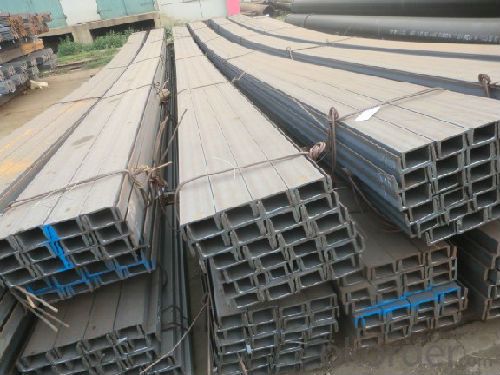
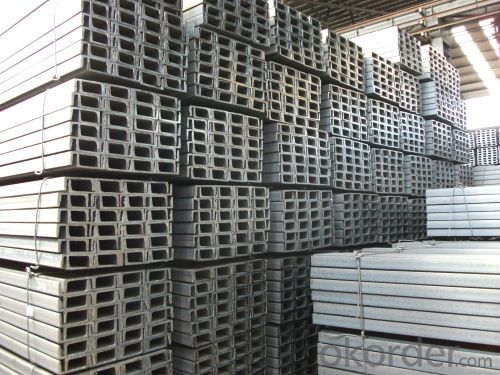
- Q: How are steel channels protected against rust and corrosion?
- There are various methods available to protect steel channels from rust and corrosion. Coatings are commonly used and can be applied to the surface of the steel channel to create a barrier between the metal and the surrounding environment. Examples of coatings include paint, epoxy, or galvanized coatings. Paint coatings are effective in preventing direct contact between the steel and corrosive elements in the atmosphere such as oxygen and moisture. Epoxy coatings, on the other hand, offer excellent protection against corrosion and are highly resistant to chemicals. Galvanized coatings involve applying a layer of zinc to the steel channel, which acts as a sacrificial layer, corroding in place of the steel. Another method to protect steel channels from rust and corrosion is electroplating. This process involves depositing a thin layer of metal, like zinc or chromium, onto the surface of the steel channel through an electrochemical process. The metal layer acts as a barrier against corrosive elements, preventing them from reaching the steel. Corrosion inhibitors can also be used to protect steel channels. These chemicals can be added to the environment surrounding the steel channel, either through coatings or by using inhibitors in the water used for cooling or other processes. Corrosion inhibitors form a protective layer on the surface of the steel, preventing corrosion from occurring. Regular maintenance and cleaning are important in preventing rust and corrosion on steel channels. Prompt removal of accumulated dirt, dust, or other contaminants is crucial, as they can trap moisture against the steel surface and accelerate corrosion. Regular inspections of the steel channels, along with immediate addressing of any signs of damage or corrosion, can also help prevent further deterioration. In conclusion, a combination of coatings, electroplating, corrosion inhibitors, and proper maintenance practices can effectively protect steel channels from rust and corrosion, prolonging their lifespan and ensuring their structural integrity.
- Q: What is the weight of a steel channel?
- The weight of a steel channel is determined by a range of factors, including its dimensions and thickness. Typically, steel channels are quantified based on their weight per foot or weight per meter. To ascertain the weight of a steel channel, it is necessary to possess knowledge regarding its dimensions, encompassing the height, width, and thickness. Through the utilization of the suitable formula or referring to a steel weight chart, you can ascertain the weight of a steel channel.
- Q: Can steel channels be used for signage installations?
- Yes, steel channels can be used for signage installations. Steel channels provide a sturdy and durable framework for mounting and supporting signage. They are commonly used in outdoor signage installations, such as billboards, roadside signs, and large-scale displays. Steel channels offer excellent structural integrity and can withstand various weather conditions, ensuring the stability and longevity of the signage. Additionally, steel channels can be customized and fabricated to suit the specific requirements of the signage, allowing for precise installation and alignment. Overall, steel channels are a reliable and robust choice for signage installations.
- Q: Can steel channels be used for modular construction systems?
- Yes, steel channels can be used for modular construction systems. Steel channels are versatile and can be easily fabricated to create modular components such as beams, columns, and support structures. They provide excellent strength and durability, making them suitable for supporting heavy loads in modular construction. Steel channels can be easily connected and integrated into modular systems, providing a flexible and efficient construction solution. Additionally, the use of steel channels allows for easy customization and adaptability to different project requirements and designs.
- Q: What are the different methods of joining steel channels?
- There are several methods of joining steel channels, including welding, bolting, riveting, and adhesive bonding.
- Q: What is the weight per foot of various steel channel sizes?
- The weight of various steel channel sizes per foot can differ depending on the specific dimensions and thickness of the channel. Steel channels are typically identified by their depth, width, and weight per foot. For instance, a steel channel with a depth of 6 inches and a weight of 8.2 pounds per foot will have an approximate weight of 8.2 pounds per linear foot. Similarly, a steel channel with a depth of 10 inches and a weight of 15.3 pounds per foot will have an approximate weight of 15.3 pounds per linear foot. It is worth noting that these weights are approximate and may slightly vary based on the specific manufacturing process and tolerances. Additionally, different steel alloys or grades may have slightly different weights per foot. Therefore, it is always advisable to refer to the manufacturer's specifications or reference tables for the precise weight per foot of a specific steel channel size.
- Q: Can the bypass of the overhanging layer on the site be made of channel steel? How can I put the channel steel, if possible?
- JGJ130 2016.10.6 when the cantilever beam and the structure of the steel plate bolt connection fixed suspension type steel, steel plate size should not be less than 100mm * 10mm (width * thick); when the bolt angle plate connection, angle specifications shall not be less than 63mm * 63mm * 6mm.
- Q: Are steel channels resistant to pest infestation?
- Steel channels are not susceptible to pest infestation. Unlike materials such as wood or plastic, steel does not provide a food source or nesting environment for pests like termites, ants, or rodents. Steel channels are made of strong and durable material, which pests cannot easily penetrate or damage. Therefore, steel channels are an excellent choice for areas where pest infestation is a concern.
- Q: What are the different types of connections used for steel channels in roof trusses?
- There are various types of connections used for steel channels in roof trusses, including welded connections, bolted connections, and riveted connections.
- Q: Are steel channels suitable for modular construction practices?
- Yes, steel channels are suitable for modular construction practices. Steel channels are commonly used in modular construction due to their versatility, strength, and ease of installation. They provide structural support and can be easily assembled and disassembled, making them ideal for modular construction where flexibility and efficiency are key.
Send your message to us
U Channel Steel/Steel Channel /Galvanized Steel Channel Dimensions
- Loading Port:
- Tianjin
- Payment Terms:
- TT or LC
- Min Order Qty:
- 25 m.t.
- Supply Capability:
- 20000 m.t./month
OKorder Service Pledge
OKorder Financial Service
Similar products
Hot products
Hot Searches
Related keywords
